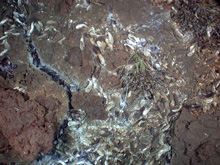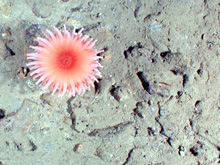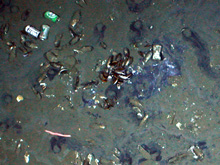
Silhouetted by the morning sun, the deep submergence vehicle (DSV) Alvin is gently lifted off the deck of the research vessel (R/V) Atlantis. Click image for larger view and image credit.
A solitary coral-like polyp captured with the downward-looking still camera on the DSV Alvin. Click image for larger view and image credit.
Monday Afternoon at 2,200 Meters
May 15, 2006
Stephanie Lessard-Pilon
Graduate Student
Penn State University
27°38.68 N
088°21.90 W
![]() This short video clips shows a very "quick" subset of a typical DSV Alvin launch. (Quicktime, 1.61 Mb.)
This short video clips shows a very "quick" subset of a typical DSV Alvin launch. (Quicktime, 1.61 Mb.)
On Monday, I spent the day on the bottom of the ocean. How’s that for a way to begin the week?
As a graduate student studying the community ecology of the deep Gulf of Mexico in Dr. Chuck Fisher’s lab at Penn State University, I was fortunate to be the starboard observer on the deep submergence vehicle (DSV) Alvin Dive 4179 at Atwater Valley Site 340, 2,200 m depth.
The DSV Alvin’s sphere is a small chamber — about 7-ft in diameter, with three 5-in portholes — with seats for a pilot and two scientific observers. We settled in easily, prepared with clipboards ready for note-taking and sweaters for later in the dive when the temperature drops as the sub descends. Shortly after getting situated, we felt the sub shudder slightly as the research vessel (R/V) Atlantis A-frame lifted the 40,000-lb sub off the deck and carefully lowered it into the water.
Our descent was quick; it took barely more than an hour to reach the ocean floor, and we arrived directly over our intended target. As the bottom approached, I could see large carbonate slabs that had been broken and cracked. The cracks were filled with lush tubeworm growth. Ghost-white crabs perched among the worms and rocks, barely noticing our approach, and a rattail fish lay still near the bottom. I pressed my face close to the small viewport, and in my excitement, I nearly forgot to turn on the video camera that would record our 9-hr expedition. We began exploring the immediate area and soon reached an extremely dense mussel bed, where dead mussel shells surrounded several different species and size-classes of live mussels. Small pale shrimp and crabs swam freely among the mussels. Bacterial mats and brine-stained sediment surrounded the bed. We slowed to take a series of overlapping images with a high resolution, down-looking camera. I will use these images in my research to create photomosaics of deep-sea communities, and then study the relations between the different species and their environment.

This image of tubeworms and a variety of mussel species was taken with the downward-looking still camera on the DSV Alvin. The sea floor is littered with dozens of old mussel shells. Live mussels can be seen in the top left corner of the image and within the crevice on the left. Click image for larger view and image credit.
Once we finished taking pictures for the mosaic, we motored to a site rich in tubeworms, passing over a purple octopus trying unsuccessfully to grab some crabs with one of its tentacles. We were startled by small orange anemones "running" across the sediment; strange behavior, considering anemones don’t have legs. When we got a closer look, we realized that the anemones had actually settled on the backs of hermit crabs. Striped and purple sea cucumbers appeared next, and we collected one of these slippery animals with the sub’s manipulator arm. Our next task involved staining the tops of tubeworms dark blue to help us track how quickly they grow and how long they live. We also succeeded in collecting a compact bush of tubeworms and the animals associated with them. All of these collections will help us learn about the physiology and ecology of these animals and communities.
Our last task on the sea floor involved collecting mussels to study the symbiotic bacteria that live in their gills. With our final few minutes, we made our way across a stretch of sediment covered with brine and bacteria. We reached our final destination, a large area of scattered mussels and quickly collected our final "treasure."
Chief pilot Bruce Strickrott radioed the R/V Atlantis for permission to surface. I pressed my face close to the viewport to catch my last glimpse of the sea floor. As we reached positive buoyancy and slowly rose in the water column, I looked for one final moment at the mussels, anemones, fishes, crabs, and tubeworms. As the bottom faded away, I saw beer cans, large loops of wire fishing line, and a bright blue diving bag scattered about the bottom. These incongruous human traces served as a reminder to me of just how far human influence extends: hundreds of miles from shore and 2,200 m below the ocean surface.
Sign up for the Ocean Explorer E-mail Update List.






























